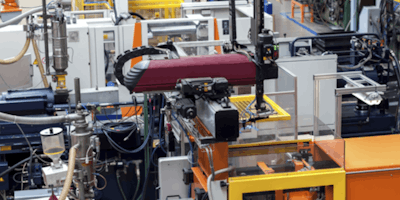
Info
General manufacturing
Predicting the future
of digitalization
Looking beyond mere productivity gains and toward new
results-based business models
Manufacturers in all segments, from food and beverage to industrial machinery and equipment, know that
digitalization is coming and they need to adapt or risk obsolescence. They all want to find an easy way to do that.
But there’s no easy method for achieving digitalization, also known as digital transformation or Industry 4.0.
Research shows manufacturers are ready to move forward, but with small steps in carefully controlled pilot
projects. While this a move in the right direction, manufacturers should also recognize that short-term initiatives will
not offer the massive gains of an enterprise-wide re-vamp of processes. The true potential of digitalization will
come from new revenue streams and outcome based selling. That type of strategy must start at the top, and
start now.
2Predicting the future of digitalization Industry Perspectives
From hype to readiness:
Manufacturers are ready to
move into action
Manufacturers are ready to adopt digitalization
strategies, research shows. They just aren’t sure
how—or why. Despite the extensive media hype and
discussion among industry pundits, many
manufacturers still lack clarity around possible
revenue models and return on investment (ROI) that
can be expected from adopting disruptive digital
technologies.
That’s understandable. New technologies have hit
manufacturers in wave after wave. The speed of
change has reached unprecedented levels. With
manufacturers still recovering from the recent
recession, they must now rebuild their foundational
systems, while also preparing for digital future.
But manufacturers have reached a critical moment for
making decisions. Consulting firm LEK, says, “IoT and
connected products coupled with data analytics
threaten to disrupt established market relationships,
introduce new competitive dimensions, and challenge
existing business models. Yet the potential
opportunities are enormous. Although the destination
is becoming clearer, the journey to commercial
transformation is proving to be challenging for many
industrial companies.”
Manufacturers seem to know that they are not as
prepared as they should be. Deloitte reports that
nearly 90% of respondents to a recent survey
conducted by MIT Sloan Management
Review anticipate that their industries will be disrupted
by digital trends to a great or moderate extent, but
only 44% say their organizations are adequately
preparing for the disruptions to come.
Predictions for the coming year suggest that
manufacturers are ready to act, at least in small steps,
rather than giant leaps of faith. As more pilot projects
produce successful results, more manufacturers will
likely rush into deployment. There will be no stopping
the momentum.
The big goal
Projections about the impact of digitalization are huge.
The World Economic Forum conducted a “value at
stake” analysis which suggests that the combined
value—to society and industry—of digital
transformation across industries exceeds $100 trillion
over the next 10 years. WEF stresses that value
doesn’t come from profit for stakeholders alone, but
will also be measured by social and wellness
improvements. WEF explains it by saying:
“Digital transformation provides industry with
unparalleled opportunities for value creation. It used
to take Fortune 500 companies an average of 20
years to reach a billion-dollar valuation; today’s digital
startups are getting there in four. Digital technologies
are creating new profit pools by transforming
customer expectations and how companies can
address them. At the same time, digitalization could
produce benefits for society that equal, or even
surpass, the value created for industry—the mass
adoption of autonomous vehicles and usage-based
car insurance, for instance, could save up to 1 million
lives by 2025.”
3Predicting the future of digitalization Industry Perspectives
Baby steps
Early adopters ready to take action in the coming year
will find few best practice models and proven tactics
to use as starting points. Any major digital
transformation initiative launched in the next year or
two might amount to a leap of faith, but
forward-thinking executives know that the leap is
inevitable. Making bold decisions and embracing risk
are common characteristics of those companies who
already classify themselves as digitally mature.
Deloitte says nearly 80% of digitally mature
companies take active steps to encourage a
corporate culture of risk taking, innovation,
collaboration, and change acceptance.
Some risk-adverse manufacturers may prefer to sit on
the sidelines, while others might opt for a pilot
program with carefully controlled parameters and
short-term objectives. Manufacturers who are early
adopters of digitalization already tend to apply new
concepts to existing problems, such as improving
shop floor scheduling, workforce productivity, and
preventive maintenance for shop assets with the help
of smart sensors and automation. These are areas in
which the problems are well-defined and the solutions
are relatively easy to grasp and implement.
But those projects may not usher in the same kind of
high impact results as an enterprise-wide
transformation could bring. And manufacturers must
be careful to keep one eye on long-term,
comprehensive goals, while they test out theories on
short term, isolated applications. In fact, manufacturers
may be missing the true potential of digitalization if
they only focus on short term goals such as
increased productivity.
Boston Consulting Group (BCG) recently conducted
a survey of manufacturers about adoption of Industry
4.0 technology, the umbrella term which typically
includes Internet of Things, data science, mobility,
digital commerce, and cloud deployment. Nearly 90%
of manufacturers surveyed say they consider adopting
Industry 4.0 technologies as a way to improve
productivity. But only 28% see it as a way to generate
increased revenue, and a mere 13% consider
digitalization as a path to a new revenue model.
Numerous obstacles were cited by companies as they
struggle to put disruptive technologies in place. Over
40% said changing the company culture and way of
thinking about technology was the biggest hurdle to
implementation. Lack of interconnected departments
(20%), changing business models (15%), and the
challenge of hiring a right-skilled workforce (13%) were
also cited as challenges in the BCG survey.
Lack of a comprehensive view and enterprise-wide
strategy will likely produce limited results, far below
the potential, experts warn. “The real value (of
digitalization) is achieved when manufacturers
maximize the impact of these advances by combining
them in a comprehensive program,” says Justin Rose,
a BCG partner and a coauthor of the survey report.
Unfortunately, one-third of those surveyed admit that
the lack of a clear strategy has been an obstacle.
“Manufacturers recognize the potential of the digital
technologies known collectively as Industry 4.0 to
create value, but they are largely approaching the
opportunity in piecemeal fashion and may miss out on
the significant business benefits these technologies
offer,” says an Industry Week article about the survey.
Despite these challenges, manufacturers must make
progress in moving toward digitalization in order to
remain competitive. Authors of the BCG report say,
“Bold ambitions and speed are essential. A
cross-functional innovation team should conduct
experiments, iterate fast and rapidly scale up new
solutions. Battle-tested program-management
techniques can keep the large-scale, multiyear effort
on track.”
4Predicting the future of digitalization Industry Perspectives
Bigger leaps yield bigger gains
In the coming year industrial organizations will
continue to take a hard look at their role in the total
value chain, whether they operate in a business to
consumer (B2C) or business-to-business (B2B)
business model. Manufacturers will zero in on those
activities with the greatest potential for creating value,
efficiency, customer loyalty, or revenue.
Consulting firm LEK says, “This strategic focus is
fundamentally changing the nature of what companies
do, and whom they do it for. Industrial manufacturers,
for example, are expanding their business models
both upstream and downstream to tap into more
lucrative profit pools. In many cases, manufacturers
are also creating portals and opportunities of
engagement, such as product personalization, to get
closer to the consumer. Industrial distributors, in turn,
are seeking strategic partners to enhance their digital
capabilities (e.g., ecommerce, data analytics) to
counter threats of disintermediation and
margin erosion.”
LEK projects that manufacturers will also shift from
selling products to selling outcomes. Outcome-based
business model means that the manufacturer provides
the desired end result or service, without necessarily
selling a physical product. For example, instead of
selling HVAC or refrigeration equipment to a
commercial developer, the manufacturer might sell
conditioned air, or refrigerated space for a restaurant.
The manufacturer provides the equipment, but still
owns it, maintains and manages it, replacing or
repairing as needed to provide the optimal
end results.
Monetizing data
This type of business model also generates data
which can be monetized. Returning to the HVAC
example, the equipment manufacturer will collect
considerable amounts of data generated from sensors
embedded in the equipment. This data can be used to
create benchmark guidelines, projections on
equipment lifespan, and trends in energy spikes. This
type of data can be packaged and sold to a range of
interested parties. This is data already collected and
aggregated. Turning it into revenue is a logical,
profitable step—but one that not all manufacturers are
embracing yet.
LEK says, “Shifting to an organizational focus on
customer outcomes is not easy. It often involves
training personnel in customer processes and may
require significant organizational change to deliver on
the promise of improved customer outcomes.” The
LEK report goes on to describe the type of top-down
commitment and investment that will be required,
saying, “Adaptation will require fundamental changes
in how industrial manufacturers are organized, how
they develop new capabilities, and how they
approach partnering. Above all, such transformation
will require a great deal of leadership and
change management.”
Ruby
CMYK: 10, 100, 100, 2
CMYK Color Palette
Graphite
CMYK: 25, 18, 12, 55
Coral
CMYK: 0, 65, 100, 0
Amber
CMYK: 0, 38, 100, 0
Citrine
CMYK: 2, 10, 100, 0
Jade
CMYK: 42, 0, 100, 0
Emerald
CMYK: 60, 0, 95, 0
Ruby
Light: 10, 100, 100, 2
Dark: 10, 100, 100, 22
Graphite
Light: 25, 18, 12, 55
Dark: 25, 18, 12, 75
Coral
Light: 0, 65, 100, 0
Dark: 0, 65, 100, 20
Amber
Light: 0, 38, 100, 0
Dark: 0, 65, 100, 0
Citrine
Light: 2, 10, 100, 0
Dark: 0, 38, 100, 0
Jade
Light: 42, 0, 100, 0
Dark: 60, 0, 95, 0
Emerald
Light: 60, 0, 95, 0
Dark: 65, 0, 100, 20
Turquoise
Light: 71, 0, 48, 0
Dark: 71, 0, 48, 20
Topaz
Light: 61, 0, 0, 0
Dark: 75, 20, 0, 0
Azure
Light: 75, 20, 0, 0
Dark: 95, 45, 0, 0
Cobalt
Light: 95, 45, 0, 0
Dark: 87, 70, 0, 0
Sapphire
Light: 87, 70, 0, 0
Dark: 87, 70, 0, 20
Amethyst
Light: 67, 90, 0, 0
Dark: 67, 90, 0, 20
Tourmaline
Light: 4, 94, 46, 0
Dark: 4, 94, 46, 20
Turquoise
CMYK: 71, 0, 48, 0
Topaz
CMYK: 61, 0, 0, 0
Azure
CMYK: 75, 20, 0, 0
Cobalt
CMYK: 95, 45, 0, 0
Sapphire
CMYK: 87, 70, 0, 0
Amethyst
CMYK: 67, 90, 0, 0
Tourmaline
CMYK: 4, 94, 46, 0
All about timing and action
Learn more about Infor manufacturing
solutions at infor.com
Copyright ©2017 Infor. All rights reserved. The word and design marks set forth herein are trademarks and/or registered trademarks of Infor and/or related
affiliates and subsidiaries. All other trademarks listed herein are the property of their respective owners. www.infor.com.
641 Avenue of the Americas, New York, NY 10011
Share this :
INF-1613477-en-US-0117-1
While projections on rate of adoption and advice on how to begin may differ, there is one mandate that seems to
be universally prescribed by industry experts: Do something, and do it soon. At the very least, this is the time for
evaluating your options and making plans. Today’s unprecedented rate of change can cause even global
enterprises to topple after a missed step or a revolutionary start-up changes the market. Thoughts of Kodak®,
Blackberry®, Blockbuster®, and Borders® Bookshop, all victims of changing markets, should be sufficient
reminder that a company needs to adapt or risk demise.
Even if a massive undertaking is not possible now, a pilot project is a good way to at least start thinking about
digitalization and examining how it can be leveraged.
Manufacturers should also keep in mind that investing in technology is not the only step. Leadership and an
engaged workforce are also critical elements. Those are areas which can be addressed, even if capital is
restricted. Accenture summed it up well, saying, “Winners in the digital age do much more than tick off a checklist
of technology capabilities. They know their success hinges on people. The ability to understand changing
customer needs and behaviors is, of course, vital. But the real deciding factor in the era of intelligence will be a
company’s ability to evolve its corporate culture to not only take advantage of emerging technologies, but also,
critically, embrace the new business strategies that those technologies drive.”






















